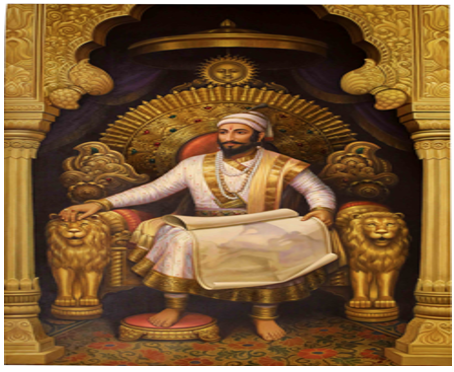Context:
The National Gallery of Modern Art (NGMA) recently hosted an exhibition to mark the 350th anniversary of Shivaji’s coronation.

Key Highlights of the Exhibition
• Exhibition Announcement:
- To commemorate the 350th anniversary of Chhatrapati Shivaji Maharaj’s grand coronation, a significant event in India’s history, the NGMA hosted an exhibition titled “Chhatrapati Shivaji Maharaj: Celebration of the 350th Anniversary of the Great Coronation”.
• Exhibition’s Notable Aspects:
- The exhibition opens with a pivotal scene: a young Shivaji, barely fourteen, receiving the saffron flag from his father Shahaji.
- This symbolic act signifies the birth of a dream, an independent Maratha kingdom, Swarajya.
- The narrative then pans through a series of major military and naval events, highlighting Shivaji’s strategic genius, particularly his selection of Fort Raigad as his bastion.
• Canvas Collection:
- The exhibition showcases larger-than-life, mesmerizing canvases from the collection of Deepak Gore, who has years of experience managing artist Jehangir Vazifdar’s gallery.
- Witnessing the magnificence of European oil paintings, he envisioned creating a collection with a strong, locally-rooted narrative.
- This vision brought the legend of Shivaji Maharaj to life on canvas.
- These paintings depicting acts of benevolence and his defiance against European domination offer a glimpse into his multifaceted leadership.
Chhatrapati Shivaji Maharaj: A Legendary Maratha Ruler
- Chhatrapati Shivaji Maharaj was a legendary Maratha ruler who established a powerful kingdom in the 17th century.
• Early Life and Rise to Power (1630-1674)
- Born in 1630 at Shivneri Fort, Shivaji was the son of Jijabai (Mother) and Shahaji Bhonsle (Father) who was in service of the Bijapuri Sultanate.
- In his teens, Shivaji began capturing strategic forts in the Deccan region, challenging the dominance of the Adilshahi Sultanate.
- He employed innovative guerilla warfare tactics, focusing on mobility, surprise attacks, and leveraging the rugged Deccan terrain.
- Shivaji established a strong navy to counter Mughal and Adilshahi control of maritime trade routes.
• Consolidation of Maratha Power (1674-1680)
- Shivaji led the Marathas in confronting Mughal dominance and asserting their authority in central India.
- In 1674, Shivaji was crowned as Chhatrapati (emperor), formally establishing the Maratha Empire.
- He focused on building a competent administration (Ashta Pradhan), establishing an efficient revenue system and creating a strong military.
- Shivaji promoted social justice and religious tolerance, protecting peasants and various religious communities within his kingdom.
Also Read
India Unveils $500 Billion Investment Opportunities in Clean Energy

